The Japanese yen had an uneventful week and edged higher on Monday. USD/JPY is trading at 130.06 in the European session, up 0.18%.
US PCE slows to 4.4%
Last week wrapped up with Core PCE slowing to 4.4% in December, down from 4.7% a month earlier. However, the month-over-month reading showed a gain of 0.3%, after three straight declines. This means that it’s still too early to assume that inflation has peaked, and the annualized reading indicates that inflation is more than double the Fed’s target of 2%. The takeaway from this is that the Fed will likely remain aggressive with its rate policy even though there are clear signs that the economy is slowing down.
The Fed holds its policy meeting on Tuesday and Wednesday, with a 25-bp increase a virtual certainty. The Fed is still hoping it can pull off a soft landing, thanks to slowing inflation and a better economic outlook – GDP expanded by 2.9%, stronger than the 2.6% forecast. The markets are of the view that the Fed will cut rates late in the year, but the Fed hasn’t given any such indication, and Fed Chair Powell has said that the markets are underestimating Fed policy. It will be interesting to see how the dollar reacts after the meeting.
In Japan, inflation indicators have hit 41-year highs, adding pressure on the BoJ to exit its stimulus programme. The BoJ insists that inflation will peak at 3% in March. but this view seems over-optimistic, given the trend we’re seeing from inflation data. BoJ Governor Kuroda has said he will maintain the Bank’s ultra-loose policy until wages increase, which would indicate that inflation is driven by domestic demand rather than cost-push factors. Kuroda winds up his term in April, and the burning question is whether the new governor will tighten policy, which would likely strengthen the yen.
USD/JPY Technical
- 129.46 is a weak support level. The next support line is 128.40
- There is resistance at 130.89 and 131.69












